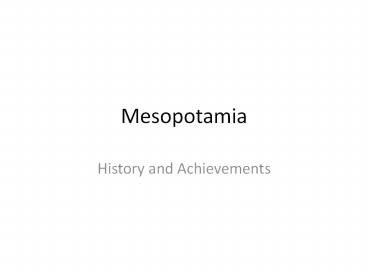Mesopotamia PowerPoint PPT Presentation
Title: Mesopotamia
1
Mesopotamia
- History and Achievements
2
MESOPOTAMIA
- Mesopotamia means "the land between the rivers"
or "the land between the two rivers." This was
the site of the world's first civilization,
Sumer.
3
CRADLE OF CIVILIZATION
- Mesopotamia is often referred to as the "cradle
of civilization" because the world's first
civilization occurred there.
4
TIGRIS AND EUPHRATES
- The Tigris and Euphrates Rivers begin in eastern
Turkey, flow in a southeast direction, converge
in southeast Iraq, and empty in the Persian Gulf.
In ancient times, the land between the twin
rivers was called Mesopotamia which was the site
of the world's first civilization.
5
SUMER
- Sumer was the world's first civilization. It was
located in the southern area of Mesopotamia where
the twin rivers converged. The people who lived
in this area were called Sumerians.
6
LEVEES
- In order to control the destructive seasonal
flooding of the Tigris and Euphrates Rivers, the
ancient Sumerians constructed levees, or raised
areas of earth, in order to hold back the
floodwaters.
7
IRRIGATE
- The ancient Sumerians irrigated, or watered,
their crops by using a system of irrigation
canals. By devising such a irrigation system, the
ancient Sumerians were able to successfully
establish a permanent civilization.
8
CITY-STATE
- The ancient Sumerians organized themselves into
competing city-states. A Sumerian city-state
consisted of the city, the surrounding mud brick
wall, and the surrounding farmland.
9
ZIGGURAT
- The ziggurat was a temple. It was located in the
center of each Sumerian city-state. It housed the
city-state's patron god. The term ziggurat means
"mountain of god" or "hill of heaven." Since the
ziggurat was a sacred place, only priests could
enter it.
10
CUNEIFORM
- The ancient Sumerians created the world's first
writing system known as cuneiform. The term
cuneiform means "wedge-shaped." Sumerian writing
is wedge-shaped because of the the type of
instrument that was used to create it.
11
STYLUS
- The ancient Sumerians used a stylus to write. A
stylus is a wedge-shaped instrument made out of
reed. The Sumerians wrote on wet clay tablets
with a stylus.
12
EDUBBA
- An edubba is a Sumerian school where young boys
learned reading, writing, and arithmetic.
13
SCRIBE
- After graduating from a Sumerian school, a young
man became a scribe, or a writer.
14
PRIEST-KING
- In early ancient Sumerian history, the powerful
priests were also the kings of the city-states.
15
GILGAMESH
- Gilgamesh is one of ancient Mesopotamia's most
legendary historical figures. He was a heroical
priest-king from the Sumerian city-state of Uruk.
16
EMPIRE
- An empire is a collection of kingdoms under the
power of one powerful ruler.
17
SARGON I
- Around 2300 B.C., Sargon I created the world's
first empire in the area of ancient Mesopotamia.
Since he was from the northern reaches of
Mesopotamia known as Akkad, the world's first
empire was Akkadian.
18
HAMMURABI OF BABYLON
- About 1800 B.C., the Amorites moved into
Mesopotamia. They established their own
city-states, and Hammurabi was the king of
Babylon. He conquered the Akkadians and ruled all
of Mesopotamia. His reign is often described as
the "Golden Age of Babylon"because he established
many new reforms.

